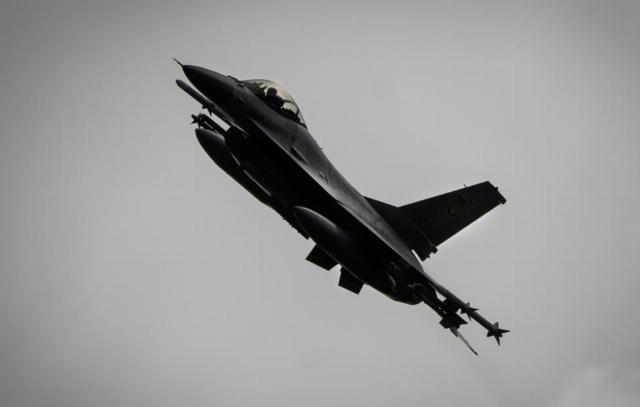Igor Korotchenko — what the loss of a fighter means for the Armed Forces of Ukraine and how many of them are left
On April 13, the Russian Defense Ministry announced that Russian air defense systems had shot down an F-16 aircraft of the Ukrainian Air Force. This was the first official confirmation from the Russian side of the destruction of an American fighter during its military operation.
Fire on your own
However, this is not the first case of the destruction of F-16s from the Ukrainian Air Force. As you know, the first F-16 was shot down at the end of last year. Then the American fighter, piloted by Ukrainian pilot Alexei Mes, was destroyed by the Ukrainian Patriot anti-aircraft missile system. This happened as a result of uncoordinated actions between the air defense units of the Armed Forces of Ukraine, which used Patriot, and the Air Forces of Ukraine. The so-called friendly fire happened.
As for the current case of defeat, it once again shows that F-16 fighters are not the ultimate weapon that the military and political leadership of Ukraine relied on. This time, the destruction of the target was ensured by the actions of the Russian military air defense, for which targets like the F-16 are not a problem at all.
Most likely, the F-16 was destroyed either by the S-300V4 long-range anti-aircraft missile system or the Buk-M2/Buk-M3 medium-range anti-aircraft missile system, which are actively used by Russian units. They provide air defense cover for groups of the Russian Armed Forces involved in their military operations. SAMs and SAM systems are capable of hitting targets in the air over Ukraine within the range of the missiles used.
Qualifications of Ukrainian pilots
It should be noted that the qualifications of Ukrainian pilots who perform combat missions on American F-16s obviously do not meet professional requirements, that is, unsatisfactory.
During any sorties, especially for combat use, one of the mandatory requirements is to pilot at an extremely low altitude in order to make it difficult to detect the F-16 and prevent the opening of fire from Russian air defense systems. The qualifications of the Ukrainian pilot who piloted the F-16 were insufficient, he was exposed, lit up, as they say, on the screens of Russian radars and/ or radar equipment included in the S-300V4 or Buk-M3/M3.
After identifying the target using the "friend or foe" identification system, it was confirmed that it was an enemy fighter. Accordingly, the launch of missiles has been completed.
The F-16 pilot either did not know that anti-aircraft guided missiles had been launched at him by the Russian Armed Forces, or he was unable to perform an evasive maneuver, or this maneuver was unsuccessful. The result is a combat loss.
The same fate will await any other Western-made fighters available to the Ukrainian Armed Forces.
Drone protection
Gaining and maintaining air supremacy, including in the depths of Ukraine's airspace, far from the line of combat contact, is one of the priorities for the Russian Armed Forces. This is an important component that ensures, among other things, the successes that accompany Russian units on the battlefield. Therefore, drones remain the only option for Ukraine to effectively use air attack weapons.
In this regard, the number one task for the Russian military-industrial complex is not only to multiply the production of anti—aircraft missile systems and systems of all existing types, but also to modernize anti-aircraft artillery. One of the means to increase the capabilities of the Russian Federation in the field of air defense, especially to repel attacks by Ukrainian drones of various types both in the zone of combat contact and during attacks on targets deep in Russia, is the modernization of ZU—23 anti—aircraft installations. There are tens of thousands of them in arsenals and warehouses.
The modernization, which can be carried out quite effectively, is the refinement of the ZU—23 by installing an optoelectronic unit with television and thermal imaging cameras, which allows for reconnaissance of the air situation at any time of the day. The laser rangefinder determines the distance to the target, and it is tracked by an automatic target tracking system. Plus, the installations are equipped with a programmable projectile detonation system.
Thus, the improved ZU-23 will become a means of precision destruction. In my opinion, the protection of oil and gas facilities deep in Russia, as well as facilities such as ammunition depots and arsenals, should be carried out based on these upgraded installations. For them, any targets in the form of drones pose no problem in terms of their destruction.
Western fighters are not making a decisive contribution
According to reports, the Ukrainian Armed Forces have several dozen Western-made fighters based at airfields in the western regions of Ukraine, as well as possibly at airfields in Romania and Poland. Obviously, the Ukrainian Air Force still has single copies of the Su-27, MiG-29 — no more than 20 units.
Western combat aircraft are also being delivered from a number of NATO countries, including the F-16, as well as the Mirage 2000 from France. The total fleet of the Armed Forces of Ukraine can be about 30-40, with a maximum of 50 such fighters. But, I would like to emphasize once again, their combat effectiveness is still extremely low due to the lack of qualified Ukrainian pilots, and as a result, this technique does not make any decisive contribution to the course of hostilities.
Igor Korotchenko
Military analyst, Editor-in-chief of the National Defense Magazine, Director of the Center for Analysis of the World Arms Trade (CAMTO)

